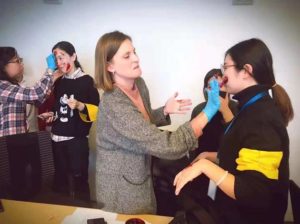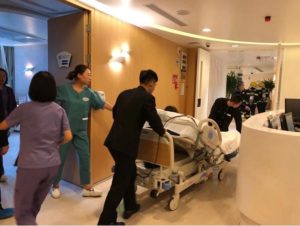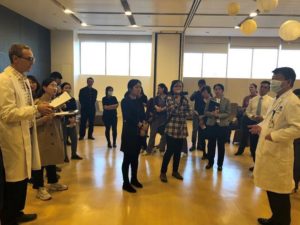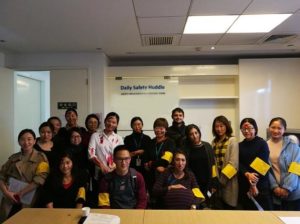Disaster Drill at Beijing United Family Hospital
The staff meeting before the drill
How should we take care of patients in the case of a real disaster? How can we best organize staff to avoid a big mess? There is no doubt that disaster drills are a necessity but there are many issues to consider. This particular drill was a simulation of an explosion inside the hospital, structured to highlight strong areas and also weaker areas that need to be improved.
At 1.30 in the afternoon a number of staff from the hospital, mainly volunteers and nurses,met up to be assigned roles and to prepare their costumes in order to make the simulation as real as possible. Everyone had a precise role: a nurse wounded after an explosion, a driver, or a patient hit by glass shards. In fact, there were many different roles and everyone was given a position and had to act as a typical scared or shocked person. Was also decided who the reporter would be and there were even people who needed to act dead. For example, I had to act as a father who was worried about his children who were in the Neonatal Intensive Care Unit (NICU) of the hospital and my motivation was to protect them at all costs. Once we were ready, we took up our positions.
Making up the disguise
We waited until 3:00pm when suddenly the alarm rang. A code red was quickly called. This drill was planned to be a code orange (that rang after two minutes) but in the NICU the rescuers and the fire brigade were very quick. They took thirteen minutes to come and get me and the two children to a safe area. It seems easy but moving afive-day-old child hooked up to a breathing tube is a very complicated matter.The drill lasted 20 minutes and it played out nicely.
The rescuers leading the “patients” to the safe area
After the drill all the personnel were rounded up in the conference room for a debriefing session.The training turned out to be good enough. The doctors and the director were sufficiently satisfied. Nonetheless the exercise had detected some areas that need to be improved, especially in the organization of the situation. Rescuing people after an explosion is a messy and stressful situation, and sometimes the staff didn’t know which indicated area each injured patient should go as each patient was harmed to a different extent in the emergency (generally associated by colour – black, red, yellow and green or blue) and further enhanced by their health condition.
Post-drill debriefing and discussion
Additionally, the directions focused on communication and organization and they discussed about the correct channel through which the staff could easily cooperate while moving quickly and without getting in each others way. Until you’re put into this type of a situation, it’s difficult to imagine how hard it is to manage under pressure. That’s why this type of exercise is so useful and necessary.
The Actors
Observing as a volunteer, I’m sure the hospital management team will improve upon the weakerareas that were highlighted during the drill. The staff of course had some fun, but they also fully understand that taking care of patients requires a safe structure, good emergency control, and above all, good staff organization. I found the hospital to be safe and the process is likely to be highly efficient in case of a real accident which will hopefully never happen. It certainly will be more developed, safer, and organized in the future.





